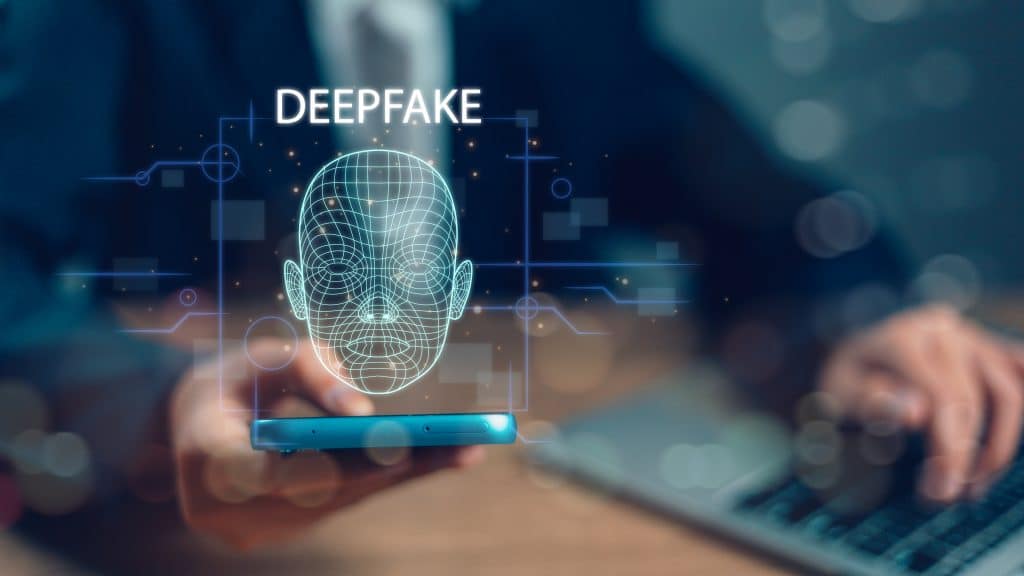Deepfake scandals: New US laws protecting digital identities

Anúncios
New legislation in the US is taking aim at the growing menace of deepfake technology, crafting legal frameworks to protect digital identities and restore public trust.
Anúncios
The surge of deepfake scandals has turned this issue from a technical curiosity into a national concern, forcing lawmakers to confront the dark side of artificial intelligence.
As synthetic media blurs the line between truth and deception, the question remains: can the law keep up? This article dives into the world of deepfake scandals and reveals how new U.S. laws are reshaping the fight for authenticity in the digital age.
The escalating threat of deepfake technology
In recent years, deepfake technology has progressed from a niche online curiosity to a mainstream concern, capable of creating highly realistic, yet entirely fabricated, images, audio, and video.
Anúncios
This section delves into the origins and capabilities of deepfakes, illustrating why deepfake scandals pose such a unique and dangerous threat to digital identities and broader societal structures.
Deepfakes leverage advanced artificial intelligence, specifically a branch called generative adversarial networks (GANs), to superimpose existing images or videos onto source images or videos.
This process allows for the convincing alteration of a person’s appearance, voice, or actions, making it appear as though they said or did something they never did.
The sophistication of these illicit creations continues to grow, blurring the lines between reality and fabrication.
Origins and evolution of deepfakes
The term “deepfake” emerged around 2017, driven by a Reddit user who used AI to swap faces in pornographic videos.
Since then, the technology has rapidly evolved, moving beyond simple face swaps to encompass voice cloning, body manipulation, and the generation of entirely new human likenesses, fueling the rise of deepfake scandals across industries.
- Early deepfakes often exhibited noticeable artifacts or inconsistencies.
- Recent advancements have made them increasingly difficult to distinguish from genuine media.
- Accessibility of deepfake tools has lowered the barrier to entry for malicious actors.
The darker implications became apparent quickly. From non-consensual pornography to political misinformation, deepfake scandals have revealed the devastating potential of synthetic media.
Political figures, celebrities, and even ordinary citizens have become targets, facing reputation damage and psychological distress.
The potential for foreign adversaries to interfere in democratic processes through deepfake scandals adds another layer of urgency for robust legal measures.

Current legislative landscape and state initiatives
In response to the growing deepfake threat, various states across the US have begun enacting legislation aimed at curbing their misuse.
These laws directly address the kinds of deepfake scandals that have shaken public confidence in digital authenticity.
Many state laws focus on non-consensual intimate imagery or electoral interference. These efforts represent a crucial first step, but the patchwork nature of state laws underscores the need for a national strategy.
Key state-level legislation
California, Texas, and Virginia are among the states that have passed significant deepfake legislation.
California’s AB-730, for example, prohibits malicious distribution of deepfakes of political candidates near elections, while AB-602 targets non-consensual deepfake pornography, two common sources of deepfake scandals.
- California (AB-730, AB-602): Focuses on political deepfakes near elections and non-consensual imagery.
- Texas (HB 501, HB 684): Prohibits deepfakes intended to influence elections or create non-consensual intimate material.
- Virginia (HB 2606): Criminalizes deepfake intimate images without consent.
While positive, these state laws vary widely. This unevenness allows deepfake scandals to persist when perpetrators exploit legal loopholes or jurisdictional gaps.
Victims often struggle to find consistent remedies across state lines.
Federal efforts to combat deepfakes
While state initiatives provide localized protection, the interconnected internet demands a federal response.
Federal lawmakers are increasingly aware that deepfake scandals transcend borders, requiring a cohesive national framework.
Several bills have been introduced in Congress to define deepfake crimes and set uniform penalties. The aim is to protect Americans from deepfake scandals that threaten elections, reputations, and security.
Proposed federal legislation and key bills
The “Deepfake Prevention Act” seeks to criminalize deepfakes used to defraud, harass, or harm.
Other initiatives, like the “Disclose Act,” require transparency for AI-generated political ads, helping voters recognize potential deepfake scandals before they spread.
- DEEPFAKES Accountability Act: Criminalizes malicious creation or distribution of deepfakes.
- AI Disclosure Act: Mandates disclosure for AI-generated content.
- No Fakes Act: Protects individuals’ likenesses from unauthorized replication.
These bills represent growing federal recognition of deepfake scandals as national threats.
However, lawmakers must balance free speech with protection against fraudulent content, ensuring that artistic and satirical uses are not unintentionally penalized.

Challenges in deepfake legislation and enforcement
Despite progress, numerous challenges persist in drafting and enforcing deepfake laws.
Proving malicious intent in deepfake scandals can be difficult, as perpetrators often hide behind anonymity or foreign servers.
The rapid evolution of AI ensures that legal definitions quickly become outdated. The borderless nature of the web further complicates enforcement.
Defining deepfakes and proving intent
One of the main difficulties lies in crafting legal definitions that capture the full scope of deepfake scandals without criminalizing parody or harmless experimentation.
Attributing intent requires advanced digital forensics and international collaboration.
- The line between satire and defamation can be ambiguous.
- Attributing malicious intent is challenging.
- Rapid advancements demand flexible legal definitions.
Law enforcement agencies often lack the tools to detect sophisticated deepfake scandals, leaving victims vulnerable to ongoing harm and reputational damage.
Jurisdictional complexities and global challenges
The global reach of deepfake scandals presents significant jurisdictional problems.
Content can be created in one country, hosted in another, and viewed worldwide.
Without coordinated laws, perpetrators easily evade justice.
- Cross-border deepfake crimes necessitate cooperation.
- Enforcement varies across legal systems.
- Anonymity makes tracing perpetrators difficult.
Different nations’ free speech and privacy standards add complexity.
Only through multilateral cooperation can governments effectively contain deepfake scandals and establish a reliable global legal framework.
The role of technology in deepfake detection and prevention
Beyond laws, technological solutions are essential.
Researchers are developing AI systems to detect and prevent deepfake scandals, identifying inconsistencies in imagery, voice, or motion that reveal synthetic origins.
As deepfakes become more advanced, so too must the detection tools that safeguard truth and authenticity online.
Advancements in deepfake detection
Machine learning algorithms can detect subtle artifacts in videos and voices, revealing the presence of deepfake scandals before they go viral.
AI-powered forensics, biometric verification, and digital fingerprinting form the foundation of detection efforts.
- AI-powered tools analyze micro-expressions and inconsistencies.
- Forensic analysis identifies synthesis artifacts.
- Biometric markers improve authentication.
While detection improves, deepfake creators constantly adapt, creating an arms race where deepfake scandals evolve as fast as their countermeasures.
Digital provenance and authenticity verification
Another strategy is digital provenance, using blockchain and watermarks to verify content origins and prevent deepfake scandals from spreading unchecked.
Such systems allow users to confirm whether a video or image is authentic.
- Blockchain provides immutable records.
- Digital watermarking embeds verification data.
- Content provenance builds trust.
Companies like Adobe and Microsoft lead initiatives like the Content Authenticity Initiative (CAI), helping restore confidence and limit deepfake scandals through transparent verification.
The future of digital identity protection
The fight against deepfakes, and the deepfake scandals they generate, will continue to shape the future of online identity.
Legislation, technology, and education must evolve in tandem to stay ahead of emerging threats.
International cooperation and ethical AI development
Global collaboration is crucial for managing deepfake scandals effectively.
Sharing research, aligning laws, and promoting ethical AI practices will strengthen defenses against synthetic media misuse.
- Harmonizing laws enhances enforcement.
- Collaborative research accelerates progress.
- Ethical AI principles prevent future abuse.
Building AI ethics into design processes can prevent deepfake scandals before they occur, ensuring technology is used responsibly and transparently.
The importance of digital literacy and public awareness
An informed public remains the best defense.
Educating people to spot deepfake scandals, question viral content, and verify sources strengthens societal resilience.
Media literacy programs and public awareness campaigns can demystify AI’s role in information manipulation.
- Educational initiatives teach recognition of deepfake indicators.
- Critical thinking builds digital resilience.
- Media literacy combats disinformation.
Platforms must also take responsibility by identifying and removing deepfake scandals promptly.
A collaborative approach, between governments, tech firms, educators, and users, will be key to maintaining digital trust and protecting the truth in an era of synthetic deception.
| Key Point | Brief Description |
|---|---|
| 🛡️ US Legislative Action | States and federal government are enacting laws to combat deepfake misuse, particularly in politics and non-consensual imagery. |
| 🚨 Deepfake Threats | Advanced AI technology creates convincing fake media, threatening individual reputations, elections, and public trust. |
| 🔍 Detection & Provenance | Technological solutions like AI detection and digital provenance (e.g., blockchain) are crucial for verifying media authenticity. |
| 🌐 Global Cooperation | International efforts and increased digital literacy are critical for a comprehensive defense against pervasive deepfake challenges. |
Frequently asked questions (FAQ) about deepfake scandals
A deepfake is an AI-generated synthetic media, typically video or audio, that superimposes or manipulates a person’s likeness or voice to make them appear to say or do something they didn’t. New laws are crucial because deepfakes can cause severe harm, from defamation and financial fraud to non-consensual pornography and election interference, necessitating legal protection for digital identities.
While no single comprehensive federal law explicitly covers all deepfake abuses, several bills have been introduced in Congress. These bills, such as the DEEPFAKES Accountability Act, aim to address specific deepfake misuse like fraud, harassment, or political disinformation. Existing broader laws on fraud or harassment may sometimes apply, but dedicated federal deepfake legislation is still evolving to provide clearer legal grounds.
Several US states have enacted deepfake statutes, often focusing on specific harms. California, Texas, and Virginia are prominent examples. California’s laws prohibit political deepfakes near elections and non-consensual intimate deepfakes. Texas targets deepfakes used to influence elections or create intimate material without consent. Virginia also criminalizes the creation or distribution of non-consensual deepfake intimate images.
Lawmakers face multiple challenges, including defining deepfakes broadly enough to cover evolving technology but narrowly enough to avoid stifling free speech like parody. Proving malicious intent can be difficult, and the global nature of the internet complicates jurisdiction and enforcement across borders. Balancing innovation with protection, and keeping pace with rapid technological advancements, remain significant hurdles in legislative efforts.
Technology plays a crucial role in deepfake detection through AI algorithms that analyze subtle inconsistencies in synthetic media. Digital provenance initiatives, like blockchain-based authentication and digital watermarking, help verify content authenticity from its source. These tools, coupled with ongoing research by tech companies and academic institutions, are vital for developing more robust defenses against the creation and spread of deepfakes.





